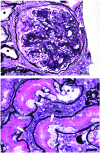Cellular and molecular mechanisms in kidney fibrosis
- PMID: 24892703
- PMCID: PMC4038570
- DOI: 10.1172/JCI72267
Cellular and molecular mechanisms in kidney fibrosis
Abstract
Fibrosis is a characteristic feature of all forms of chronic kidney disease. Deposition of pathological matrix in the interstitial space and within the walls of glomerular capillaries as well as the cellular processes resulting in this deposition are increasingly recognized as important factors amplifying kidney injury and accelerating nephron demise. Recent insights into the cellular and molecular mechanisms of fibrogenesis herald the promise of new therapies to slow kidney disease progression. This review focuses on new findings that enhance understanding of cellular and molecular mechanisms of fibrosis, the characteristics of myofibroblasts, their progenitors, and molecular pathways regulating both fibrogenesis and its resolution.
Figures



References
-
- Morel-Maroger Striker L, Killen PD, Chi E, Striker GE. The composition of glomerulosclerosis. I. Studies in focal sclerosis, crescentic glomerulonephritis, and membranoproliferative glomerulonephritis. Lab Invest. 1984;51(2):181–192. - PubMed
Publication types
MeSH terms
Substances
Grants and funding
LinkOut - more resources
Full Text Sources
Other Literature Sources
Medical

